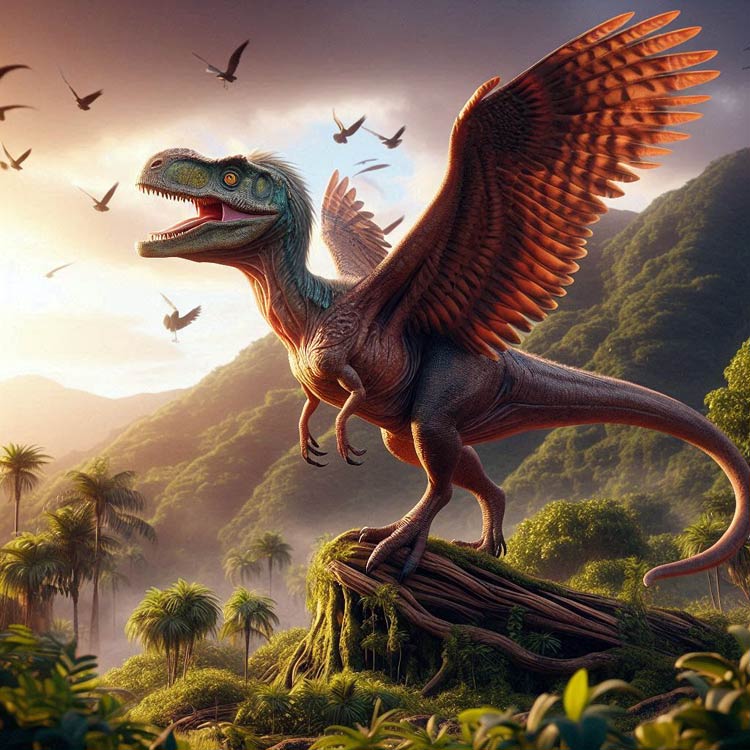Dinosaurs and the ability to fly
The evolution of flight in dinosaurs is one of the most fascinating and complex transitions in the history of life on Earth. This process involved significant anatomical and behavioral changes over millions of years, leading to the rise of the first birds from theropod dinosaur ancestors.
The Ground-Up Hypothesis
One of the primary theories explaining the evolution of flight is the “ground-up” hypothesis, also known as the cursorial hypothesis. This theory suggests that flight evolved in fast-running terrestrial dinosaurs. These dinosaurs used their feathered limbs to aid in balance and increase lift while chasing prey or evading predators.
Key points supporting this hypothesis include:
- Feathered Limbs: Fossils of small theropod dinosaurs, such as Velociraptor and Microraptor, show evidence of feathered limbs. These feathers could have initially evolved for insulation or display and later adapted for flight.
- Running and Leaping: As these dinosaurs ran and leaped, their feathered arms provided stability and lift, gradually leading to the development of powered flight.
- Wing-Assisted Incline Running (WAIR): Modern birds, such as young partridges, use their wings to help them run up steep inclines. This behavior supports the idea that feathered dinosaurs might have used their proto-wings in a similar way, gradually developing the ability to glide and eventually fly.

The Trees-Down Hypothesis
Another major theory is the “trees-down” hypothesis, also known as the arboreal hypothesis. This theory posits that flight evolved in tree-dwelling dinosaurs that glided from branch to branch.
Key points supporting this hypothesis include:
- Arboreal Lifestyle: Small theropods with feathered limbs, such as Microraptor, show adaptations for climbing and gliding, suggesting an arboreal lifestyle.
- Gliding Precursor: The initial stage of flight may have involved gliding, where feathered dinosaurs leaped from trees and used their wings to control their descent.
- Gravity Assistance: Starting from a higher elevation, these dinosaurs could use gravity to aid in the development of flight, making it easier to evolve gliding and then powered flight.
Anatomical Adaptations
Several anatomical adaptations were crucial for the evolution of flight in dinosaurs:
- Feathers: Initially evolved for insulation and display, feathers became more specialized for flight. They provided lift and enabled control of flight dynamics.
- Skeletal Modifications: The development of a keeled sternum (breastbone) allowed for the attachment of powerful flight muscles. The fusion of certain bones, such as the pygostyle (fused tail vertebrae), improved balance and maneuverability.
- Respiratory System: Birds and their dinosaur ancestors developed a highly efficient respiratory system with air sacs that allowed for a continuous flow of air through the lungs, providing the high oxygen levels needed for sustained flight.

Archaeopteryx: The Transitional Fossil
Archaeopteryx, often considered the first bird, lived around 150 million years ago during the late Jurassic period. It exhibited both avian and dinosaurian features, making it a crucial transitional fossil. Key characteristics include:
- Feathers: Archaeopteryx had well-developed flight feathers on its wings and tail.
- Skeleton: It possessed a combination of reptilian features, such as teeth and a long bony tail, and avian features, such as a wishbone and lightweight bones.
- Flight Capability: While not a strong flier by modern standards, Archaeopteryx likely had the ability to glide and make short powered flights, representing an intermediate stage in the evolution of flight.
Convergence of Theories
Recent research suggests that the evolution of flight might have involved a combination of both the ground-up and trees-down hypotheses. The process was likely gradual, with different species of feathered dinosaurs experimenting with various forms of locomotion, including running, leaping, gliding, and flapping.
Conclusion
The evolution of flight in dinosaurs was a complex and multifaceted process that took millions of years. It involved significant anatomical changes and behavioral adaptations, driven by natural selection. From the initial development of feathers for insulation and display to the sophisticated flight mechanisms seen in modern birds, this journey highlights the incredible adaptability and innovation of life on Earth. The study of this evolutionary transition continues to provide valuable insights into the dynamic nature of evolution and the interconnectedness of all living organisms.
Recommended
- From Tyrannosaurus to chicken
- Megalosaurus
- The Bone wars
- Tyrannosaurs – Birth, Reign and Twilight
- Mary Anning
- Alamosaurus – one of the largest dinosaurs
- The longest dinosaurs. Sauropods Top 10
- The heaviest dinosaurs – Top 10
- The longest predatory dinosaurs. Theropods Top 10
- The heaviest predatory dinosaurs Top 10
- Dinosaurs
- Dinosaurs database
- Pterosaur database














